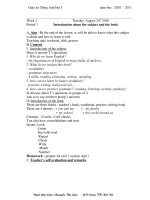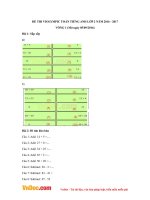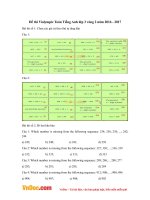De tieng Anh lop 8 HK I NH 2016 2017 De 1
Bạn đang xem bản rút gọn của tài liệu. Xem và tải ngay bản đầy đủ của tài liệu tại đây (210.86 KB, 7 trang )
PHỊNG GIÁO DỤC VÀ ĐÀO TẠO
CHÂU THÀNH
Đề chính thức
Điểm
bằng số
Điểm bằng
chữ
Giám khảo 1
Giám khảo 2
ĐỀ KIỂM TRA HỌC KÌ I, NĂM HỌC 2015-2016
Mơn TIẾNG ANH THÍ ĐIỂM, Lớp 8
Thời gian: 60 phút (không kể phát đề)
Lời phê
STT
Số tờ
Số phách
Đề thi gồm có 3 trang. Thí sinh làm bài trực tiếp vào đề thi.
LISTENING: (2, 0 ms).
A. Listen TWICE and fill the missing information into the gaps, (no more than 3 WORDS
(1m).
The house was built in the (1) ..………………………..……………………
The building became a (2) ..………………………..………………………
The art collection is in (3) ..………………………..………………………..
George Reymond was a big fan of (4) ..………………………..…………..
George Reymond was a (5) ..………………………..………………………..
B. Listen to the passage and write TRUE (T) or FALSE (F). You’ll listen TWICE. (1m)
1. Five-coloured sticky rice is a traditional dish.
2. Five-coloured sticky rice isn’t made with roots.
3. The colours represent the elements of life.
4. These elements create harmony between people.
5. This rice is only made at Tet.
II. GRAMMAR AND VOCABULARY : (2.0 ms)
A: Pick out the word which has a different sound in the underlined part in each line.
1.
A. instrument
B. dedicate
C. terrified
D. heritage
2.
A. receive
B. receipt
C. culture
D. century
B. Pick out the word which has the stress pattern different from that of the other words.
3.
A .minority
B. development
C. explanation
D. comparison
4.
A enjoyable
B. mountainous
C. religious
D. reliable
C. Choose the best option for each sentence:
5. Does she fond of ......playing piano?
A. playing
B. to play
C. play
D. played
6. We ……….do our homework today becase we have a short holiday.
A. should
B. don’t have to
C. has to
D. mustn’t
7. We have a……………..of having dinner together at weekend.
A. customs
B.traditional
C. custom
D. customer
8.People ……………. obey the traffic rules strictly.
A. must
B. had been
C. have
D. may
9. We have a ………………………lesson in a fable.
A. custom
B. fairy
C. bad
D. moral
10. What a………………….bear it is. It keeps all the honey for itself.
A. generous
B. cheerful
C. greedy
D. wicked
D. Read the text and choose the correct options.
An increasing number of people are now going on(1)....... to Egypt. Last year, for
example, about one and a half million(2)........visited Egypt. The (3)........of Egypt is about fifty
million people and the(4)..........is El Qahira (Cairo), a busy city of just under nine million people.
Although the.........(5)............is hot and dry and most of the country is desert, the average
temperature(6)………October to March is not too high. The most.....(7)...........places are the
pyramids at Giza. However, it is also pleasant to...........(8)...........Alexandria, Port Said and
several other places and do as much sightseeing(9).......... possible in the time available. A......
(10).........to Luxor is an unforgettable experience.
1. A. visit
B. holiday
C. travel
D. excursion
2. A. tourists
B. passengers
C. voyagers
D. explorers
3. A. person
B. citizenship
C. nation
D. population
4. A. town
B. head
C. state
D. capital
5. A. temperature B. climate
C. condition
D. position
6. A. in
B.on
C. from
D. at
7. A. famous
B. known
C. asked
D. requested
8. A. search
B. inspect
C. examine
D. visit
9. A. so
B. such
C. as
D. that
10. A. pinic
B. trip
C. guide
D. entertainment
III. READING: (2.0 ms)
A. Read and choose the correct answers
Money is what you use to buy things. You may earn money from completing household chores,
getting good grades, for your allowance, or for losing a tooth! Money is very important in our world
and comes in many different forms.
People have been using money for hundreds of years. Before money gave specific values for
things, people simply traded items. In the United States, we use the dollar as our currency or money,
but people in different parts of the world use different currencies, though some countries also use or
accept the dollars.
People earn money from the jobs they work and use that money to save for the future or pay for
expenses such as their houses, cars, goods, taxes, medical needs, and household items. Even things
like turning the lights on, using the air conditioning or heat, and connecting to the internet cost
money.
1.Where do people use the dollars?
A. In the USA
C. All over the world
B. Other countries
D. A and B are correct.
2.How long have people used money?
A. Since the beginning of time
B. They started recently
C. Hundreds of years
D. Thousands of years
3. According to the author of this story, money is ____________.
A. not very important
C. only used in America
B. only earned by adults
D. very importan
4. What did people do before there was money
A. The story doesn't tell
B. People exchanged to get what they needed
C. They made everything themselves
D. They just never got what they needed
5. People use money for………………….main purposes.
A. two
B three
C. four
D.five
B. Read the paragraph and writ TRUE (T) or FALSE (F) for the statements.
As trees grow old they add a new ring for each year, this discovery, it seems, was first made by
Leonardo da Vinci, the famous Italian painter and scientist. It took a long time, however, before the
serious study of tree rings started; this was done in Arizona by Andrew Ellicott Douglas.
Douglas developed a simple technique for dating trees called cross-dating and for a period of
over twenty years continued the study of tree rings. He spent much of his time in logging camps
near Flagstaff.
The Douglas method has been used by many scientists. Some of them used it to examine logs in
Indian pueblo ruins; they were able to date the buildings right back to the tenth century. Others used
it to date the world's oldest living trees, the bristlecone pines.
1. Leonardo became famous because of his tree ring discovery.
2. Leonardo's discovery was not developed for many years.
3. It took Douglas more than 20 years to developed a tree-dating technique.
4. Logging camps are good places for studying tree rings.
5. The Douglas method has been used since the 10th century.
IV. WRITING (2.0 ms)
A. Complete the sentences with the correct forms of the words provided
1. If you write ……………………….. you will get bad marks ( careless)
2. He was ill but he tried to ………………………… on the lesson. (concentration)
B. Use the words in brackets to rewrite the sentences with similar meaning to the original
ones
3. My friends run faster than me. (slowly)
………………………..………………………..………………………..……………
4. It’s necessary for students to obey the school rules. (have to)
………………………..………………………..………………………..……………
5. The team tried hard.The team couldn’t win the game. (although)
………………………..………………………..………………………..……………
C. Make notes about one of your favorite folk tales including:
Tilte
Main characters
Plot : beginning; middle; end.
V. SPEAKING (2ms)
- THE END ANSWERS
I.
LISTENING: (2, 0 marks)
(STUDENTS GET 0.2M FOR EACH CORRECT ANSWER)
A. Listen TWICE and fill the missing information into the gaps, (no more than 3 WORDS
(1m)
1. 19(th) century
2. National museum
3. (the) dining room
4. Traditional art
5. lawyer
B. Listen to the passage and write TRUE (T) or FALSE (F). You’ll listen TWICE. (1m)
1. T
2. F
3. T
4. F
5. F
II. GRAMMAR AND VOCABULARY : (2.0 marks)
(STUDENTS GET 0.1M FOR EACH CORRECT ANSWER)
1. A
2. C
3. C
4. B
5. A
6. B
7. C
8. A
9. D
10. C
Read the text and choose the correct options.
1. B
2. A
3. D
4. D
5. B
6. C
7. A
8. D
9. C
10. B
III. READING: (2.0 marks)
( STUDENTS GET 0.2M FOR EACH CORRECT ANSWER)
A.
1.
2.
3.
4.
5.
Read and choose the correct answers.
D
C
D
B
A
.
B. Read the paragraph and writ TRUE (T) or FALSE (F) for the statements.
1. F
2. T
3. T
4. F
5. F
IV. WRITING (2.0 marks)
( STUDENTS GET 0.2M FOR EACH CORRECT ANSWER)
A. Complete the sentences with the correct forms of the words provided:
1. CARELESSLY
2. CONCENTRATE
B. Use the words in brackets to rewrite the sentences with similar meaning to the original
ones
3. I run more slowly than my friends.
4. Students have to obey the school rules.
5. Although the team tried hard, the team /(they) couldn’t win the game/
The team couldn’t win the game although they tried hard.
D. Make notes about one of your favorite folk tales including:
Tilte: (0.2 m)
Main characters: (0.2 m)
Plot : beginning; middle; end. (0.6 m)
V. SPEAKING (2ms)
- THE END -
Tapescript
Tapescript bài nghe số1
Good morning everyone and welcome to Stonebridge House. My name is David and I’m your
tour guide. This morning, I’m going to show you around this wonderful 19th century house
which was the home of the Reynold family for more than 150 years, until 1975 when it
became a national museum.
We are now standing in the main lobby of the house where you can see the manigficent
wooden staircase that leads up to the bedrooms. The servants used to sleep in the attic but they
would have useda different staircase to this one. Now if we go through the dining room you
will be able to see a fine collection of paintings. George Reynold was abig fan of traditional
art as we can se here today. George came from a military family. Surprisingly, however, he
became a lawyer , even though his father had wanted him to be an officer in the army.
Tapescript bài nghe số 2
Five- colored sticky rice is an important traditional dish of many ethnic minorities in the
northern mountainous regions. People call the dish five-colored sticky rice because it has five
colors: red, yellow, green, purple and white. The things that create the colors are not chemicals
but natural roots and leaves. The five colors of the dish represent five elements of life
according to Vietnamese beliefs: yellow is earth, red is fire, green is plants, white is metal, and
purple or black is water. People believe that these five elements create harmony between
heaven and earth. Five-colored sticky rice is usually made and enjoyed at Tet, in festivals and
ceremonies, on special occasions, and whenever the family has guests.
THE TOPICS FOR THE SPEAKING SKILLS- GRADE 8
Thí điểm
I.
LEISURE ACTIVITIES
1. What do you usually do in your free time?
2. How long have you had your hobby?
3. Tell some good leisure activities.
4. Who do you share your hobby with?
………
II.
LIFE IN THE COUNTRYSIDE
1. Tell some differences of the countryside between the past and now
2. What you you like best about the countryside
3. What you don’t like about the countryside
………………………..
III. CUSTOMS AND TRADITIONS
1. Tell some customs and traditions in our country at Tet.
2. What do you do at Tet?
3. What we should/shouldn’t do at Tet
4. What we should/shouldn’ wear in the church or pagoda?
………………………………
IV. FESTIVALS IN VIET NAM
1. Tell some names of festivals in Viet Nam.
2. What you do to celebrate a festival?
3. What festival you would like to experience? Why?
………………………..
V.
FOLK TALES.
1. Tell some names of folk tales.
2. What’s your favorite folk tale?
3. Retell your favorite folk tale.
4. Why you like that folk tale.
…………………………….
GUIDELINES TO MARK IN SPEAKING TEST
Students work in pair, they choose the topic, and ask some questions related to the
topic. They can use their own questions related to that topic.
The students are assessed on
The content
The grammar
The intonation
The pronunciation









